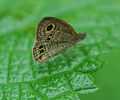Ypthima baldus
| Common Fivering | |
|---|---|
 | |
| Scientific classification | |
| Kingdom: | Animalia |
| Phylum: | Arthropoda |
| Class: | Insecta |
| Order: | Lepidoptera |
| Family: | Nymphalidae |
| Genus: | Ypthima |
| Species: | Y. baldus |
| Binomial name | |
| Ypthima baldus (Fabricius, 1775) | |
| Synonyms | |
| |

The Common Fivering Ypthima baldus is a species of Satyrinae butterfly found in Asia.
Description
- See glossary for terms used
Wet-season form
_I_IMG_9504.jpg)
Male: Upperside brown, both fore and hind wing with terminal margins much darker, and generally with more or less distinct subbasal and discal dark bands. Fore wing with a large, slightly oblique, oval, bi-pupilled, yellow-ringed black, pre-apical ocellus. Hind wing with two postdiscal, round, uni-pupilled, similar but smaller ocelli, and very often one or two minute tornal ocelli also.
Underside similar to the underside in Y. philomela but the ochraceous-white ground-colour paler, tin-transverse brown strice coarser, the ocelli on the hind wing more distinctly in echelon, two tornal, two median, and two pre-apical, and on both fore and hind wing more or less distinctly defined, subbasal, discal and subterminal brown transverse bands.
Female: Differs on the upperside in having the area surrounding or bordering the ocelli on both fore and hind wing paler, closely irrorated with brown striae, the discal transverse band generally clearly defined, and very often both the tornal, and at least one of the apical, ocelli distinct. On the underside it is paler than the male, and has the subbasal, discal and subterminal transverse dark bands more clearly defined.[1]
Dry-season form
_on_Mikania_micrantha_(Bittervine%2C_Mile-a-minute%2C_American_rope%2C_Chinese_creeper)_in_Kolkata_W_IMG_3727.jpg)
-_Dry_season_form_in_Kolkata_W_IMG_3738_.jpg)
Males and females:Upperside very similar to the above, paler; in the female often the ground-colour ochraceous white, closely irrorated with brown striae ; ocelli as in the wet-season form, but those on the hind wing often non-pupilled. Underside also paler than in the wet-season form, the subbasal, discal and subterminal bands on the whole more prominent; ocelli on the hind wing reduced to mere specks.[1]
Wing expanse of 38-46 mm.
Distribution
Sub-Himalayan India from Chamba to Sikkim and Bhutan. Central India and the hills of southern India and the Western Ghats. Assam, Myanmar and the Tenasserim.[1]
Subspecies
- Ypthima baldus baldus (India to Indo China, Burma, Thailand, southern Yunnan)
- Ypthima baldus hyampeia Fruhstorfer, 1911 (southern Ussuri, Korea)
- Ypthima baldus jezoensis Matsumura, 1919 (Kuriles)
- Ypthima baldus luoi Huang, 1999 (Yunnan)
- Ypthima baldus marshalli Butler, 1882
- Ypthima baldus moerus Fruhstorfer, 1911
- Ypthima baldus newboldi Distant, 1882 (Peninsular Malaya, Langkawi, Singapore)
- Ypthima baldus okurai Okano, 1962 (Taiwan)
- Ypthima baldus pasitelides Fruhstorfer, 1911 (Bawean)
- Ypthima baldus selinuntius Fruhstorfer, 1911 (Borneo, Natuna Islands)
- Ypthima baldus zodina Fruhstorfer, 1911 (Taiwan)
Gallery
-
_in_Talakona%2C_AP_W_IMG_8588.jpg)
in wet season at Talakona forest, in Chittoor District of Andhra Pradesh, India.
-
_mating_at_Samsing%2C_Duars%2C_West_Bengal_W_IMG_5985.jpg)
in dry season at Samsing in Darjeeling district of West Bengal, India.
-
_at_Samsing%2C_Duars%2C_West_Bengal_W_IMG_5914.jpg)
in dry season at Samsing in Darjeeling district of West Bengal, India.
-
_at_Samsing%2C_Duars%2C_West_Bengal_W_IMG_5911.jpg)
in dry season at Samsing in Darjeeling district of West Bengal, India.
-
_at_Samsing%2C_Duars%2C_West_Bengal_W_IMG_5908.jpg)
in dry season at Samsing in Darjeeling district of West Bengal, India.
-
_at_Jayanti%2C_Duars%2C_West_Bengal_W_IMG_5498.jpg)
in dry season at Jayanti in Buxa Tiger Reserve in Jalpaiguri district of West Bengal, India.
-
_at_Jayanti%2C_Duars%2C_West_Bengal_W_IMG_5497.jpg)
in dry season at Jayanti in Buxa Tiger Reserve in Jalpaiguri district of West Bengal, India.
-
-_dry_season_form_on_Mikania_micrantha_(Chinese_creeper)_at_Narendrapur_W_IMG_4135.jpg)
in dry season on Mikania micrantha (Chinese creeper) at Narendrapur near Kolkata, India.
-
-_dry_season_form_on_Mikania_micrantha_(Chinese_creeper)_at_Narendrapur_W_IMG_4133.jpg)
in dry season on Mikania micrantha (Chinese creeper) at Narendrapur near Kolkata, India.
-
-_dry_season_form_at_Narendrapur_W_IMG_4268.jpg)
in dry season at Narendrapur near Kolkata, India.
-
-_dry_season_form_at_Narendrapur_W_IMG_4174.jpg)
in dry season at Narendrapur near Kolkata, India.
-
-_dry_season_form_at_Narendrapur_W_IMG_4162.jpg)
in dry season at Narendrapur near Kolkata, India.
-

in dry season at Narendrapur near Kolkata, India.
-
_I_IMG_9495.jpg)
in wet season at Narendrapur near Kolkata, India.
-

Mating in wet season at Botanical Gardens, Kolkata, West Bengal, India.
-

Mating in wet season at Botanical Gardens, Kolkata, West Bengal, India.
-

in dry season at Narendrapur near Kolkata, West Bengal, India.
-

in dry season at Narendrapur near Kolkata, West Bengal, India.
-

-

References
| Wikimedia Commons has media related to Ypthima baldus. |
| Wikispecies has information related to: Ypthima baldus |